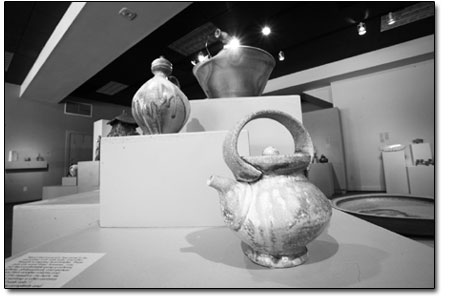|
| ||||
| East meets West
by Jules Masterjohn Since the turn of the 20th century, European and American artists have been enamored with the aesthetics of Asian, Oceanic and African art. One of the earliest and most oft-cited cases of “art envy” is Picasso’s incorporation of African masks in his paintings from the early 1900s. The simplified forms found in African and other tribal cultures, so different from the French taste for excessive ornamentation, appealed to the interest in exploring new aesthetic territory. Our love affair with that which is foreign and exotic continues today. An example of this fascination can be seen in the current ceramic invitational exhibition, “Wabi Sabi,” on display at the Durango Arts Center. It sounds exotic, so just what is wabi sabi? Do your homework before going to view the 80+ pieces in the show, for there is no information in the gallery about this ancient Japanese philosophy. Reading the many statements by the artists may give some clues, but viewers are left alone to figure out wabi sabi for themselves. In the exhibit press release, the term is defined as “a Japanese aesthetic that is imperfect, impermanent and incomplete. In art it can include asymmetry, asperity, simplicity, modesty, intimacy and suggest a natural process.” I was able to discern some of these qualities in the work presented, but just why the work of these 28 potters and artists was brought together to embody a Zen Buddhist concept was confusing. When drafting this exhibit list, DAC exhibits committee member and show organizer, J Burnite, looked to many of the people who show annually in the David Hunt Invitation at Fort Lewis College as well as a number of others he met at a wood-fired conference in Flagstaff. As such, “Wabi Sabi” presents a variety of ceramic processes and some interesting work by ceramic artists new to showing in Durango as well as those familiar to us from the region. Author Andrew Juniper, in his book Wabi Sabi: The Japanese Art of Impermanence writes, “If an object or expression can bring about, within us, a sense of serene melancholy and a spiritual longing, then that object could be said to be wabi-sabi.” Author of Wabi Sabi Simple, Richard R. Powell offers, “It (wabi-sabi) nurtures all that is authentic by acknowledging three simple realities: nothing lasts, nothing is finished, and nothing is perfect.”
Ian Altman, Michele Rhodes, Trevor Dunn and John Bradford each present pottery that hints at a traditional rustic aesthetic, often associated with the Japanese tea ceremony. When gazing upon the numerous earthy-looking pots, whose surfaces are marred by the harshness of the kiln’s heat and marked by flashings of soda, salt and wood ash, one notices their imperfections. So, too, the work by Logan Wannamaker exemplifies this aesthetic. Some surfaces are rough, cracked, and distressed. His wheel-thrown vessel “Breaking Point” looks as if it narrowly escaped its demise in the kiln: a large crack runs down and splits the full belly of the pot. His wall triptych, “Inside the Fire,” is aptly named, rising, like a phoenix, above many of the other atmosphere-fired pieces in the show. He writes, “The clay’s decision to take on a specific identity in the process of creation is something in which I try not to interfere.” By contrast, Scott K. Roberts offers three refined, wheel-thrown, covered jars, each wrapped and tied with straw. Kay Harper Roberts’ wrapping handiwork is intricate, directly inspired by traditional Japanese packaging techniques. Concerns for form and function as well as the mark of the hand make a showing in the work of Lorna Meaden, Peter Karner, Lisa Pedolsky and Jennifer Neff. The vessels presented by these artists are a visual and conceptual shift from the idea of chance so prevalent in the rustic work mentioned earlier. Meaden’s vessels are made for daily use and beg to be held. She writes, “Handmade pots are potent in their power to reveal the extraordinary, within the ordinary.” Karner, like an alchemist, relies on the chemical interaction of his layered glazes to decorate his elegant stoneware vessels. Pedolsky, ever the consummate craftsperson, presents a delicate a box-like tray that holds four nesting small cups, and is characteristically etched with calligraphic lines. Like a diamond in the rough, Jennifer Neff’s intimate, hand-pinched porcelain form, “Origin,” with its liquid-like glaze, sings quietly and brilliantly by itself. In the work by these last six artists, human hands and minds intervene, leaving the domination of the fire behind. • Lisa Pedolsky will offer a free lecture, entitled “Process,” on her conceptual and technical processes on Tues., Feb. 17, from 6:30–8 p.m. at the Durango Arts Center. “Wabi Sabi” continues through Feb. 25 at the DAC, 802 E. Second Ave. Gallery hours are 10 a.m.-5 p.m, Tuesday-Saturday.
|



